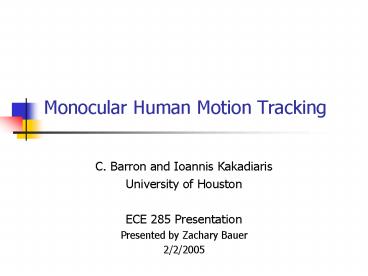Monocular Human Motion Tracking - PowerPoint PPT Presentation
1 / 23
Title:
Monocular Human Motion Tracking
Description:
Develop an algorithm to do 3D motion capture from a monocular, uncalibrated camera. ... Input from uncalibrated monocular camera or synthetic computer graphics images. ... – PowerPoint PPT presentation
Number of Views:36
Avg rating:3.0/5.0
Title: Monocular Human Motion Tracking
1
Monocular Human Motion Tracking
- C. Barron and Ioannis Kakadiaris
- University of Houston
- ECE 285 Presentation
- Presented by Zachary Bauer
- 2/2/2005
2
Problem Statement
- Given an image sequence (from a fixed monocular
camera) of a moving human, estimate his or her
motion by estimating the corresponding pose of an
essentially determined (up-to-scale) Virtual
Human model (VHM) at each frame of the image
sequence.
3
Goals
- Use a detailed VHM to model human movement.
- Develop an algorithm to do 3D motion capture from
a monocular, uncalibrated camera. - Ensure algorithm is efficient, simple, and robust.
4
Proposed Solution
- Semiautomatically initialize VHM model to first
acceptable image frame. - Fit VHM to image by calculating the
Sum-of-Squared Intensity Differences (SSD)
between the VHM projection and the image.
5
Proposed Solution
- Use penalty factors to make SSD minimization
problem convex and tractable. - Decompose minimization problem into smaller
problem subsets - chest-neck-head
- left arm
- right arm
- left leg
- right leg.
6
Sum-of-Squared Differences (SSD)
- VHM(0)Cx,y is a projection of the VHM into 2D.
- P is the coordinates of a pixel
- Vp is the intensity value at p in the projected
VHM image. - Vp is the intensity value at p in the current
image.
7
Virtual Human model (VHM)
- 18 joints
- 57 degrees of freedom
- Represented as a set of arrays of position and
appearance (xsi,ysi,zsi,rsi,gsi,bsi)
8
System
- Input from uncalibrated monocular camera or
synthetic computer graphics images. - Use color information for segmentation.
- Use intensity information to track.
- Computer system used? Unknown
- Run-time? - Unknown
9
STEP 1 Semiautomatic Initialization
- User selects landmarks on figure in first
image. - Algorithm fits VHM to landmarks.
- User adjusts girth of VHM segments to fit the
segmented person.
10
STEP 2 Update VHM
- Update VHM by assuming the pixels values using
the overlap between the VHM and the current
image. - Map visible 3D VHM points onto 2D image of the
camera plane.
11
STEP 3 Estimate Position
- Estimate position of each segment
(i.e.-CHEST-NCK-HD, LARM, etc.) separately to
reduce problem size. - Work from the hips out.
12
STEP 3 (cont.)
- Map each segment into spherical coordinates.
- Check a small arc of rotations and perform
Penalized SSD.
13
STEP 4 PSSD Minimization
- Use the penalizing factors to weight the SSDs to
make them convex. - Find the global minima in the PSSD (Penalized
SSD). This point corresponds to the VHM segment
rotation that best matches the image segment.
14
STEP 4 (cont.)
15
Penalty Factors
- Lamda(Vp) Penalty factors from VHM segments
under C. - Lamda(vp) Penalty factors for values in the
image. - Lamda 1 for pixels in a region in the image
that correspond to the subject of interest. - Lamda gtgt 1 otherwise.
16
Penalty Factors (cont.)
- Within a region of interest
- Pixels near proximal joint weighted less in SSD.
- Pixels near distal joint/segment given more
weight.
17
Penalty Factors ???
- How are these penalty factor regions determined?
- Why are the areas to be emphasized actually give
lower penalty factors?
18
Results
- The algorithm successfully tracked 3D motion the
image with high accuracy - (1 for non occluded areas).
- Robust to partial self occlusion, rapid movement,
low image quality, large displacement. - Penalty factors and minimization problem
breakdown succeeded in making the nonconvex
minimization problem tractable. - Works for monocular image, independent of camera.
19
Results (cont.)
20
Results (cont.)
Successfully tracks despite moving background,
occlusion, and low image quality.
21
Notes
- Does not focus much on segmentation
- Option between adaptive background subtraction or
color segmentation. - No discussion of shadows
- Tests generally done in uniformly lit areas.
- Very reliant on manual initialization
22
Additional Information
- Ioannis Kakadiaris
- University of Houston
- http//www.vcl.uh.edu/ioannisk/
- Other projects Optical Tracking for
Telepresence/Teleoperation Space Applications - Robust real-time 3D tracking
23
Related Information
- I. Mikic, E. Hunter, M. Trivedi, P. Cosman,
"Articulated Body Posture Estimation from
Multi-Camera Voxel Data", IEEE International
Conference on Computer Vision and Pattern
Recognition, Kauai, Hawaii, December 2001 - K. Huang and M. Trivedi, "Omni and Rectilinear
Video Arrays for Real-TimePerson Tracking,"
Submitted to PETS2001 Workshop, CVPR2001
Conference, Hawaii,Dec. 2001































